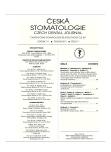Lifetime Electronic Health Record in Dentristry versus WHO Paper Card
Authors:
K. Chleborád 1; K. Zvára jr. 2,3; T. Dostálová 1; M. Seydlová 1; R. Ivančaková 4; K. Zvára 2,3; J. Zvárová 2,3
Authors‘ workplace:
Dětská stomatologická klinika 2. LF UK a FN Motol, Praha
1; EuroMISE, s. r. o., Praha
2; Oddělení medicínské informatiky, Ústav informatiky Akademie věd, ČR
3; Stomatologická klinika LF UK a FN, Hradec Králové
4
Published in:
Česká stomatologie / Praktické zubní lékařství, ročník 111, 2011, 3, s. 57-64
Category:
Practical Report
Overview
Introduction:
The electronic health record (EHR) is a computerized health information system where provider record detailed encounter information such as patient demographics, encounter summaries, medical history allergies, intolerances, and lab test histories [9]. The EHR will be used in future diagnostic and treatment decision making. The decision is always taken by a physician or dentist. Medical documentation contains information about treatment, communication with insurance service system and statistical data evaluation. The EHR may support and improve future diagnostics and therapy in general. The data can be used in statistics and other scientific purposes.
Aim:
The aim of study is to verify the simplicity of data process implementation and time of data storing for modification of classical paper WHO dental card, lifetime dental EHR controlled by keyboard and lifetime dental EHR controlled by voice.
Methods:
All three methods were applied on 126 patients. The dental status of patients was examined and the data recorded in classical way into the paper WHO dental card. The same person recorded all data to lifetime dental EHR using keyboard and using voice. Then we compared the time, which was needed for recording the data using these three methods.
Using Friedaman test we found very significant differences in time of recording among three methods (p<0.001). We can see that the paper WHO dental card was recorded quickly, but its reuse due to missing electronic form is difficult. Times for recording data using keyboard or voice in lifetime dental EHR were not significantly different (Wilcoxon pair test for statistical comparison reached the value p=0.09).
Conclusion:
The clinical practice demanded to find ways to eliminate the need to touch peripherals like keyboard, mouse and touch screen. Therefore the automatic speech recognition was added to enable dentist to use the software without a single touch. This way we eliminated the need for computer operator and unnecessary hygienic procedures (washing hands, changing gloves etc.).
Key words:
dentistry – data storing – electronic health record – voice control
Sources
1. Ceusters, V., Elkin, P., Smith, B.: Negative findings in electronic health records and biomedical ontologies: A realist approach. Int. J. Med. Inform., roč. 76, 2007, Suppl. 3, s. 326–333.
2. Commission of the European Communities DG XIII, AIM-CEN. Workshop on the Medical Record, roč. I–II, 1993.
3. Dick, R. S., Steen, E. B.; eds. The computer-based patient record: An essential technology for health care. Washington, D.C., Institute of Medicine, National Academy Press, 1991.
4. European Commission, DG XIII, Telematics applications programme (1994–1998), Work-programme, 15 December, 1994.
5. European Commission, Proceedings of the second EU-CEN workshop on the electronic healthcare record, Porto Carras, Greece, May 1997.
6. Grasso, M. A.: Automated speech recognition in medical applications. MD Computing, roč. 12, 1995, č. 1, s. 16–23.
7. Hayrinen, K., Saranto, K., Nykanen, P.: Definition, structure, content, use and impacts of electronic health records: A review of the research literature. Int. J. Med. Inform., roč. 77, 2008, č. 5, s. 291–304.
8. Hippmann, R., Dostalova, T., Zvarova, J., Nagy, M., Seydlova, M., Hanzlicek, P., Kriz, P., Smidl, L., Trmal, J.: Voice supported electronic health record for temporomandibular joint disorders. Methods Inf. Med., roč. 49, 2010, č. 2, s.168–172.
9. Ludwick, D. A., Doucette, J.: Adopting electronic medical records in primary care: Lessons learned from health information systems implementation experience in seven countries. Int. J. Med. Inform., roč. 78, 2009, s. 22–31.
10. Nagy, M., Hanzlicek, P., Zvarova, J., Dostalova, T., Seydlova, M., Hippmann, R., Smidl, L., Trmal, J., Psutka, J.: Voice-controlled data entry in dental electronic health record, technology and informatics, eHealth beyond the horizon – get it there. Proceedings of MIE, 2008, s. 529–534.
11. Noehr, C.: Evaluation of electronic health record systems. IMIA yearbook of medical informatics 2006. Methods Inf. Med., roč. 45, 2006, Suppl. 1, s. 107–113.
12. Quakk, M. J., Westerman, R. F., van Bemmel, J. H.: Comparisons between written and computerised patient histories. Br. Med. J., roč. 295, 1987, č. 3, s. 184–190.
13. WHO Oral Health Assessment form 1997. htpp://www.whocollab.od.mah.se/expl/whoform97.pdf.
14. Zvarova, J., Dostalova, T., Hanzlicek, P., Teuberova, Z., Nagy, M., Pies, M., Seydlova, M., Eliasova, H., Simkova, H.: Electronic health record for forensic dentistry. Methods Inf. Med., roč. 47, 2008, č. 1, s. 8–13.
Labels
Maxillofacial surgery Orthodontics Dental medicineArticle was published in
Czech Dental Journal

2011 Issue 3
- What Effect Can Be Expected from Limosilactobacillus reuteri in Mucositis and Peri-Implantitis?
- The Importance of Limosilactobacillus reuteri in Administration to Diabetics with Gingivitis
Most read in this issue
- Dry Socket and the Lenght of Healing Depending on the Type of the Treatment - Part One: Classical Treatment
- Frenulectomy in the Treatment of Diastema
- Oral Compliacation after Bone Marrow Transplantation
- Legitimacy of Use of Formocresol in Pediatric Dentistry History and Present of a Well-known Procedure in Pediatric Endodontics
